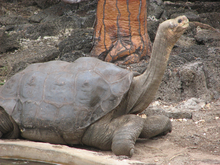Pinta Island tortoise
| Pinta Island tortoise | |
|---|---|
 |
|
| Lonesome George at the Charles Darwin Research Station in 2006, the last known individual of his species of Galápagos tortoise | |
|
Probably extinct
|
|
| Scientific classification | |
| Kingdom: | Animalia |
| Phylum: | Chordata |
| Class: | Reptilia |
| Order: | Testudines |
| Suborder: | Cryptodira |
| Family: | Testudinidae |
| Genus: | Chelonoidis |
| Species: | †C. abingdonii |
| Binomial name | |
|
Chelonoidis abingdonii (Günther, 1877) |
|
 |
|
| Map of the Galápagos Islands indicating species' locations | |
The Pinta Island tortoise (Chelonoidis abingdonii), also known as the Pinta giant tortoise,Abingdon Island tortoise, or Abingdon Island giant tortoise, is a species of Galápagos tortoise native to Ecuador's Pinta Island that is probably extinct.
The species was described by Albert Günther in 1877 after specimens arrived in London. By the end of the 19th century, most of the Pinta Island tortoises had been wiped out due to hunting. By the mid-20th century, the species was assumed to be extinct until a single male was discovered on the island in 1971. Efforts were made to mate the male, named Lonesome George, with other species, but no viable eggs were produced. Lonesome George died on 24 June 2012 and the species was believed to have become extinct with his death. However, 17 first-generation hybrids have been found at Wolf Volcano on Isabela Island during a recent trip by Yale University researchers. As these specimens are juveniles, their parents may still be alive.
"Lonesome George" along with other of the tortoises on Pinta Island, belong to a genus of 21 species. Giant tortoises were widespread on most of the continents except for Australia and Antarctica. Not only do the Galapagos tortoises remain the largest living tortoises, but in the Galapagos, distinct populations survived in multiple localities.
Several of the surviving species of Galapagos tortoises are seriously endangered. Lonesome George was the perfect example. It is said that the decline of the population began in the 17th century, due to buccaneers and whalers. They hunted tortoises as a source of fresh meat, and took away about 200,000 tortoises collectively.
This species was originally described in 1877 by German-born British herpetologist Albert Günther, who named it Testudo abingdonii, a new species, in his book The Gigantic Land-tortoises (Living and Extinct) in the Collection of the British Museum. The name, abingdonii, derives from Abingdon Island, now more commonly known as Pinta Island. The knowledge of its existence was derived from short statements of the voyages of Captain James Colnett in 1798 and Basil Hall in 1822. In 1876, Commander William Cookson brought three male specimens (along with other species of Galápagos tortoise) to London aboard the Royal Navy ship HMS Peterel.
...
Wikipedia
